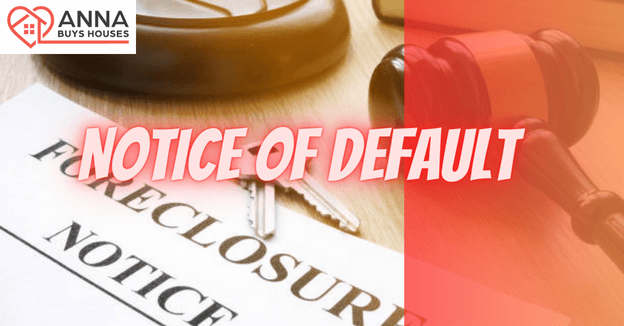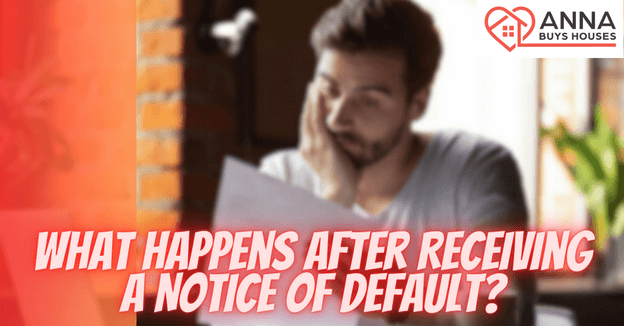Did you receive a notice of default? Discover the meaning and purpose of a notice of default, and explore your options to navigate this critical financial situation.

Introduction
In the first quarter of 2023, a total of 65,346 properties in the United States began the foreclosure process. This marked a 29% increase from the prior year. Additionally, banks repossessed a total of 12,518 properties, which was 6% more than in 2022, according to ATTOM.
Amidst this rise in foreclosures, many homeowners might feel lost on how to navigate the difficult situation of receiving a Notice of Default (NOD). Not handling an NOD well could lead to significant repercussions, such as a negative impact on your credit score and the risk of losing your home. Getting a foreclosure notice doesn’t automatically mean that you will lose your home. There are things that you can do to prevent foreclosure from happening. Homeowners must be aware of their rights in foreclosure, and the available options when they receive a Notice of Default. Understanding these rights and options can help navigate the foreclosure process effectively.
This article provides a concise overview of what a Notice of Default entails, its purpose, the stages of foreclosure, and practical options for homeowners to proactively manage the foreclosure process.
What is a Notice of Default (NOD)?
A “Notice of Default” is a legal document that serves as an initial step in the foreclosure process when you fail to fulfill your mortgage obligations. If you haven’t been able to make your mortgage payments for the past 90 days, the lender will send you a Notice of Default (NOD). This is a formal notice from the lender, informing you that you’ve defaulted on your mortgage payment and that the early stage of foreclosure, also known as “pre-foreclosure,” has begun. During this pre-foreclosure stage, the lender gives you time to resolve the default. If you fail to bring your payments up to date, the lender will proceed with foreclosure, which can take place through either a judicial or non-judicial process.
What Happens After Receiving a Notice of Default?

If you cannot resolve the default within the lender’s given timeframe, the lender may proceed with a foreclosure auction. To handle this situation effectively, it becomes necessary for you to educate yourself about the foreclosure process and timeline. Knowing your options will empower you to make well-informed decisions throughout this process.
Foreclosure Timeline
The foreclosure process generally consists of two main stages: pre-foreclosure and foreclosure. Here’s an explanation of each stage:
1. Pre-foreclosure happens when you are unable to make payments on your mortgage payments for the past 90 days. The pre-foreclosure process typically begins after the Notice of Default is issued to the homeowner. During this time, the lender gives you a specific time frame (usually 30 days) to bring your payments up to date. You can negotiate with your lender to modify your loan terms, pursue a repayment plan, or explore alternatives like a short sale. If you fail to keep up with your payments, the lender will proceed to foreclosure.
2. Foreclosure is the legal process through which a lender attempts to recover the outstanding debt by selling the property and securing the loan. Lenders have two primary methods of foreclosure: judicial and non-judicial foreclosure. Let’s take a closer look at each method:
- Judicial foreclosure is a process that involves the court system. To initiate a judicial foreclosure, the lender must file a lawsuit against the borrower. The lawsuit serves to obtain a court order to foreclose on the property. Here’s the process of judicial foreclosure:
Judicial foreclosure typically begins with the lender filing a lawsuit against you in the district court of the county where the property is located. This lawsuit will provide a detailed description of your default and the amount you owe, seeking a foreclosure order from the court. You will then be served with a copy of the foreclosure lawsuit, allowing you to respond and defend your rights in court. Should you fail to respond or if the court rules in favor of the lender, a judgment of foreclosure will be issued, allowing the lender to proceed with the sale of your property to repay the outstanding debt. The property will be scheduled for a public auction, usually overseen by the county sheriff or a court-appointed referee, and sold to the highest bidder. The winning bidder will receive a certificate of sale and, unless there is a redemption period or the property is redeemed, they will become the new owner of the property.
- Non-judicial foreclosure does not involve the court system and is typically conducted through a power of sale clause in the mortgage or deed of trust. Here’s the process of non-judicial foreclosure:
The lender will send you a notice of default (NOD) to begin the non-judicial foreclosure process. The NOD informs you about your default and provides a specific timeframe to bring your payments up to date. If you fail to cure the default within the given timeframe, the lender will proceed by recording a notice of sale at the county recorder’s office. This notice contains important details about the foreclosure sale, such as the date, time, and location. Eventually, the property will be auctioned off to the highest bidder in a public sale, typically overseen by a trustee specified in the deed of trust. The winning bidder will then receive a trustee’s deed, which legally transfers ownership of the property to them.
Take note that most Western states mainly use the non-judicial foreclosure process. Non-judicial foreclosures are less common in the Northeast, but it can be utilized where allowed, given that the mortgage or deed of trust has a power of sale clause authorizing such proceedings. If you’re involved in a foreclosure situation, it is advisable to consult with a legal professional familiar with the state’s foreclosure laws to understand your rights and obligations accurately.
Responding to a Notice of Default: What Are Your Options?

Receiving a Notice of Default (NOD) isn’t just about notifying you about your missed payment but is also a warning letting you know that your property is in the early stages of foreclosure. It’s crucial that you seek options and take action immediately to avoid foreclosure. Below are the options you can consider to resolve foreclosure:
- Negotiate with your lender: To prevent foreclosure, your first step is to negotiate with your lender. Talk to them about the available options to address your situation. Lenders are usually open to modifying your loan or establishing a repayment plan. Just remember, that you will need to provide your lender with the necessary financial information to support your request for a modification or repayment plan.
- Reinstatement: You have the option to reinstate your mortgage by paying the overdue amount along with additional fees. Choosing this option allows you to keep your home and avoid foreclosure.
- Loan Modification: A loan modification involves making permanent changes to your mortgage terms. You may have the opportunity to lower your interest rate, extend your loan term, or reduce your monthly mortgage payment. This can be a viable solution if you need help to keep up with your current mortgage payment. Keep in mind that the loan modification process can be time-consuming, taking several months, and is subject to approval.
- Forbearance: Forbearance is an agreement between you and your lender that allows you to temporarily stop or reduce your loan payments. This arrangement is typically offered when you encounter temporary financial difficulties, such as losing your job, facing medical expenses, or dealing with a natural disaster. During forbearance, you may have reduced or suspended payments, but interest may still accumulate on the loan. Forbearance provides short-term relief, allowing you to get back on track financially before resuming regular payments. However, it’s important to note that forbearance does not eliminate or discharge the debt. It only provides temporary relief and may have implications for the loan term or repayment schedule.
- Sell Your Property: If you cannot find a solution with your lender that allows you to keep your property, selling your home might be a good option to consider. In this situation, you have two choices for selling your property.
The first option is to sell your home to a direct home buyer, such as Anna Buys Houses. A direct home buyer can purchase properties quickly and in cash, allowing you to sell your home as-is without the need for repairs or renovations. This can provide you with cash to alleviate some or all of your debts, while also saving you the hassle of finding a buyer. If you have decided to sell your home quickly, contact us at 402-313-8700 to get a free, no-obligation cash offer.
If the value of your home is lower than what you owe on your mortgage, the second option is to pursue a short sale. A short sale involves selling your property for less than the amount owed on your mortgage, with the lender’s approval. It is a way to settle your debt with the lender and avoid foreclosure.
- Bankruptcy: If you find yourself in a situation where foreclosure is fast approaching, filing for bankruptcy can be your last resort. When you file a bankruptcy petition, it triggers an automatic stay that puts a stop to all collection actions, including foreclosure. This can give you temporary relief from foreclosure proceedings. However, filing for bankruptcy will damage your credit score significantly, and the damage may stay on your credit file for 7 to 10 years.
Final Thoughts
Understanding the concept of a “Notice of Default” is essential when you’re dealing with financial responsibilities and contractual agreements. Taking proactive steps upon receiving a Notice of Default is crucial to prevent foreclosure and protect your financial well-being. Keep in mind that the time given by your lender to resolve the default is limited.
If you’ve looked into every possible way to bring your payments up to date but you’re still struggling to resolve the default, it may be time to consider selling your property. Selling your home is an option that may help you avoid foreclosure and give you the opportunity for a new beginning.
Here at Anna Buys Houses, we genuinely care about your well-being and want to assist you in finding the best solution for your situation. Our experienced team is here to answer your questions, address your concerns, and guide you through the process of selling your property to a direct home buyer. Contact us now at 402-313-8700 to discuss your options and receive your no-obligation cash offer.
